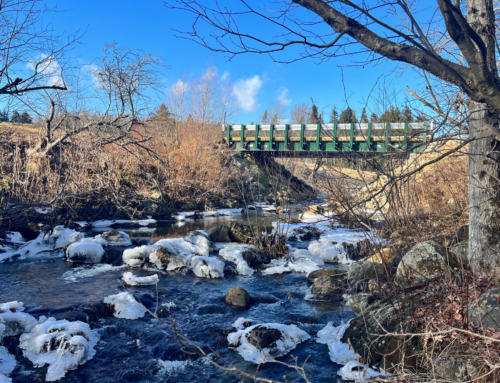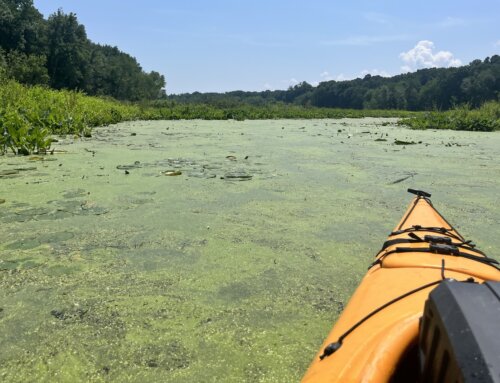Three bacteria sources removed as a result of ongoing monitoring program
Greenfield, MA. June 30, 2011 – As the summer swimming season heats up, three area organizations are teaming up again for a water quality monitoring program that has both given recreational users of the river a regular snapshot of water quality and has helped identify and clean up sources of E. coli bacteria.
Collaborating on sampling and analysis are the Pioneer Valley Planning Commission (PVPC), Connecticut River Watershed Council (CRC), and UMASS Water Resources Research Center. They are sampling locations on the Connecticut River and several tributaries and posting the results on a web site easily available to the public.
“Summer is upon us, and the Connecticut River and its tributaries are a wonderful natural resource central to our lives in the Valley,” said Andrea Donlon, River Steward for CRC . “People use the river for swimming, paddling, boating, water skiing, diving, and quiet contemplation of nature. Many users of the river often wonder if the water is clean enough for swimming. This program helps to answer that question.”
This program is designed to sleuth out problems and work with local government and landowners to fix them. CRC and PVPC collect water samples at selected tributaries that have known or suspected bacteria problems. Samples are analyzed for E. coli bacteria as an indicator of disease-causing organisms present in the water. These organisms enter surface waters from failing on-site septic systems, illicit connections of household sewer lines to storm drains, insufficiently treated wastewater, domestic and wild animal feces, and storm runoff.
PROBLEMS FOUND & FIXED IN GREENFIELD, NORTHAMPTON, AND SPRINGFIELD
“This spring, we helped the Town of Greenfield identify a hole in a sewer line that was leaking into an underground stream that drains into the Green River,” said CRC’s Donlon. “The Town is now actively engaged in fixing that problem.”
CRC’s work also helped identify a bacteria source in a stormwater outfall to the Mill River in the Florence section of Northampton. The City Department of Public Works did dye testing and identified a house with a sewer line incorrectly connected to the storm drainage line. The City has since disconnected the house from the storm drainage line, and this year has positively identified another house with an illicit connection along the same storm drainage line. Further monitoring in the downtown area has recently identified another source of bacteria.
Data collected by the PVPC allowed them to work with the City of Springfield and the Springfield Water and Sewer Commission, a failing septic system was identified as a likely source of the very high E. coli levels recorded at Bassett Marina on the Connecticut River for the past three years. To address this problem, the City plans to connect the facility to the municipal sewer. Design of the sewer connection is currently underway, with construction planned for the Fall.
MONITORING DATA AVAILABLE TO THE PUBLIC AT UMASS WEBSITE
Volunteers for PVPC and CRC are collecting samples every Wednesday during the summer at nine locations along the Connecticut River. The samples are analyzed at the CRC water quality lab, and results are posted online on Thursdays or Fridays every week at http://www.umass.edu/tei/mwwp/ctrivermonitoring.html.
Anne Capra, planner for PVPC, said, “We encourage the public to consult this web page frequently if you are a river user. Over the past four years, we have been able to provide regular monitoring data in almost real-time fashion, which was seriously lacking in the past.”
This year’s water quality monitoring project is funded through a combination of grants from the Community Foundation of Western Massachusetts, the U.S. Environmental Protection Agency under a Targeted Watershed Initiative grant, and with Federal Funds from the Environmental Protection Agency (EPA) to the Massachusetts Department of Environmental Protection (MassDEP) under an American Recovery and Reinvestment Act of 2009 Section 604(b) Water Quality Management Planning Grant. The contents do not necessarily reflect the views and policies of EPA or of MassDEP, nor does the mention of trade names or commercial products constitute endorsement or recommendation for use.
# # #
For press information contact:
Andrea Donlon, CRC River Steward 413-772-2020 ext 205 or adonlon@ctriver.org . For July 1 to July 5, Andrea can be reached at her home number at 413-625-8178.
Anne Capra, PVPC Principal Planner 413-781-6045 or acapra@pvpc.org
About CRC: Founded in 1952, CRC has worked to attain a protected and vital river ecosystem where human activity is in balance with the preservation of the region’s natural resources. As a principal citizen advocate dedicated to promoting the restoration and sustainable use of the Connecticut River watershed, CRC is restoring spawning areas for migratory fish that have been blocked by dams for hundreds of years; annually mobilizing thousands of volunteers to remove trash from local waters; and supporting three River Stewards who bring an on-river presence to every region of the watershed, taking action and assisting community groups. CRC has also protected over 8,000 acres of valuable wetlands, forests, farmlands, natural buffers and river access points.







